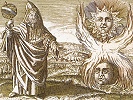
Sacred Texts Gnosticism and Hermetica Index Previous Next
Buy this Book at Amazon.com


Thrice-Greatest Hermes, Vol. 2, by G.R.S. Mead, [1906], at sacred-texts.com
This, the last piece in our Corpus, differs so greatly both in style and form of contents from the rest of our sermons, that we are plainly dealing with a different order of endeavour.
The style is for the most part so very artificial and forced, that we are conscious of labour and effort, and sometimes of such obscurity as to make a clear rendering almost impossible. The contents are of the nature of an elaborate set Eulogy of Kings.
Whether or not this concluding piece ever bore a proper title it is impossible to say, for the existing headings are plainly added by a later redactor, 2—as we
have already seen in a number of other instances. I have therefore ventured to superscribe as the main title “The Encomium of Kings,” 1 and have placed the contents-headings in parentheses.
Reitzenstein, in his analysis of the Corpus, concludes (p. 207) that this Eulogy was appended to the collection of treatises by the original redactor, or collector.
He was an Egyptian Rhetor, who was a follower of the Trismegistic tradition, and his object in making the collection was mainly to show the Rulers of the Empire that not only was there nothing in the Hermes religion that could excite their suspicion, but that, on the contrary, it was in its most fundamental teachings admirably calculated to inculcate Loyalty to the Rulers of the Empire’s destinies.
It is, indeed, to this “Apology,” so to speak, that we owe the good fortune of the preservation of our Corpus.
Who the “most noble [Sirs]” of §§ 5 and 7, to whom the Eulogy is immediately addressed, may be, is difficult to determine, for though the subject is the “Encomium of Kings” in general, some actual King was evidently in the mind of the writer when he penned § 16. Perhaps the “most noble” may have been the high officials of Egypt.
The lost conclusion of our Encomium, for our actual text is evidently incomplete, may have given clearer indications of the Emperor for whose ultimate perusal the Eulogy was intended. As it is, the indications are of the vaguest.
Reitzenstein, however, is of opinion (pp. 207, 208) that the indications in § 16 best suit the reign of
[paragraph continues] Diocletian (imp. 285-305 A.D.); but he is aware that, as far as these are concerned, an earlier date is not excluded (p. 208). It is only when he has treated, in his Addenda (pp. 371-374), the Encomium as an example of later Greek “art-prose,” or rhythmic prose, the scheme of the accentuation of which has been of late years carefully studied, especially by Meyer and Wilamowitz, that he comes definitely to the conclusion that the external form of our Rhetor’s effort fits precisely the time of Diocletian’s Triumph, 302 A.D. I cannot, however, say that I am convinced by his arguments.
The strained and elaborate introduction (§§ 1-5) needs no further comment; no doubt it is very “fine writing,” but it is difficult to pin some of it down to any precise meaning in translation.
6. With § 6, however, our interest is awakened, for it reminds us of the famous Introduction to the Protrepticus, or Exhortation to the Greeks, of Clement of Alexandria, when he says:
“I could tell thee also of another—brother to these 1—story and singer, of Eunomus the Locrian and the Pythic grasshopper.
“At Pytho there was gathered together a solemn assembly of Greeks to celebrate the Death of the Serpent, with Eunomus to sing the funeral song of the beast.
“Whether his song was a hymn or a dirge I cannot say; anyhow, there was a contest, and Eunomus had to harp it in the heat of the day, when the grasshoppers, warmed by the sun, were singing underneath the leaves along the hills.
“They were singing not to the Serpent, the dead thing, but to God the All-wise, a song of unrestrained mode far better than the modes of Eunomus.
“A cord breaks for the Locrian; the grasshopper flies on to the yoke; it chirped on the harp as on a branch; and the minstrel, modulating to the song of the grasshopper, filled up the missing string.
“It was not that the grasshopper was attracted by the song of Eunomus, as the story would have it, setting up a brazen statue at Pytho of Eunomus, harp and all, and his helper in the contest; it flew on naturally and sung naturally. The Greeks, however, thought it played the music.” 1
This passage shows that the story referred to by our author was well known, so well known indeed that Clement takes it as a text for a naturalistic explanation of Hellenic miracle. No literary dependence, however, of one or the other can be entertained, for the similarity of the “τὴν νευρὰν ἀνεπλήρωσεν αὐτῷ” of our text and the “ὁ ᾠδὸς τὴν λείπουσαν ἀνεπλήρωσε χορδὴν” of Clement is far too slight a link to bear the weight of any argument of this nature. 2
11. There is evidently a lacuna after § 10, and, judging by the opening words of § 11, it must be of some length, for the Praise of Kings so far is of a very brief description.
It is also of interest to notice how much easier the style of our author is when he treats of the Praises of God; his words seem to come far more easily, as though he had a subject to deal with with which he was more familiar, as, indeed, he ought to have been if he had studied the treatises he has collected together.
13. The idea that all his subjects are the children of the King is Egyptian; or, rather, it is the tradition of all nations who believed in Divine Kings. The true King was he who, so to speak, contained all his subjects within himself; they were all “members,” or, as we should say, cells, of his true Body. The nation was the King; the victory of the nation was ascribed to the virtue of the King. 1
14. The last three sentences of § 14 Reitzenstein (p. 208) would take as referring to the Kings under the suzerainty of the Emperor, who were bound to him by a common bond of love, in order that he may the more insist on the Diocletian date. 2 I would, however, refer the idea to the ideal of harmony and unity of the Beings of the Intelligible World, as described, for instance, by Plotinus, when he writes:
“They see themselves in others. For all things are transparent, and there is nothing dark or resisting, and everyone is manifest to everyone internally, and all things are made manifest; for light is manifest to light. For everyone has all things in himself, and again sees in another all things, so that all things are everywhere, and all in all, and each in all, and infinite the glory. For each of them is great, since the small also is great. And the sun there is all the stars, and, again, each and all are the sun. In each, one thing is pre-eminent above the rest, but it also shows forth all.” 3
Compare this also with the intuition of the seer in The Untitled Apocalypse of the Codex Brucianus:
“Their Crowns send forth Rays; the Brilliancy of their Bodies is as the life of the Space into which they are come; the Word (Logos) that comes out of their mouth is Eternal Life, and the Light that comes forth from their Eyes is Rest for them; the Movement of their Hands is their Flight to the Space out of which they are come, and their Gazing on their own Faces is Knowledge of themselves; their Giving to themselves is a repeated Return, and the Stretching out of their Hands establishes them; the Hearing of their Ears is the Perception in their Heart; and the Union of their Limbs is the Ingathering of Israel; their Holding to one another is their Fortification in the Logos.” 1
This is the Egyptian counterpart of the Plotinian Ecstasis; and Plotinus was by birth an Egyptian.
298:2 In fact, are due to the first hand in B C D M. See R. 355, 1; 358, 12.
299:1 See § 15—ἡ πρὸς τοὺς βασιλέας εὐφημία—and compare note to Clem. Alex., iii., in “Fragments from the Fathers.”
300:1 Amphion, Arion and Orpheus.
301:1 Clem. Al., Prot., i. 1; P. 2 (ed. Dindorf, i. 2).
301:2 Cf. R. 205, 206.
302:1 This belief, indeed, is the power of the Japanese in our own day.
302:2 He thus, apparently, would take the ἐκείσε as referring to these subject kings and rulers.
302:3 En., V. viii. 4.
303:1 F. F. F., 557.
SIGN UP!!! CLICK HERE TO GET 52 BOOKS FREE!!

SIGN UP!! FOR BOOKS AND REGULAR ARTICLES
https://againstsatanism.com/Prices.htm
HOW TO DEFEAT SATANISM AND LUCIFERIANISM AND BOOST YOUR EVOLUTION THROUGH ENERGY ENHANCEMENT MEDITATION "I have experience of many forms of meditation and practices for self improvement including: Transcendental meditation (TM) 12 years, Kriya Yoga 9 years, Sushila Buddhi Dharma (SUBUD) 7 years, and more recently the Sedona Method and the Course in Miracles.
The Energy Enhancement programme encapsulates and expands all of these systems, it is complete and no questions are left unanswered."
Energy Enhancement Level 0 Super Chi Prana, Power, Strength, Immortality
https://www.energyenhancement.org/LEVEL-Energy-Enhancement-Super-Chi-Immortality-Prana-Meditation-Course.htm
Energy
Enhancement Meditation LEVEL 1 Immortality - Activate the Antahkarana! Gain
Infinite Energy from the Chakras above the Head - Power UP!! Open Your Third
Eye, Gain Super Samadhi Kundalini Alchemical VITRIOL Energy. Ground All Negative
Energies. Access Quantum Immortality
Energy
Enhancement Meditation LEVEL 2 - The Energy Enhancement Seven Step Process to Totally
Remove Energy Blockages, Totally Remove All
Problems, Totally Remove Negative Emotions, Heal Your DNA, Remove your Karma -
OPEN YOUR LIFE!!
Energy
Enhancement Meditation LEVEL 3 - Eliminate even Deeper Energy Blockages - The
Removal of Strategies. Quantum Integration. The Karma Cleaning Process to
Totally Eliminate All Your Karma, all your Trauma, all your Energy Blockages
from All your Past Lifetimes!!
https://www.energyenhancement.org/Level3.htm
Energy
Enhancement Meditation LEVEL 4 - Stop the Suck!! Heal All your Relationships!! Find Your
Twin Flame!! MASTER ENERGY CONNECTIONS AND
RELATIONSHIPS
OUR SPECIAL MEDITATION REVOLUTION OFFER!!
WE HAVE THE TECHNOLOGY
WE CAN REMOVE YOUR ENERGY BLOCKAGES, ENTITIES AND DEMONS
WE CAN RE-BUILD YOU..